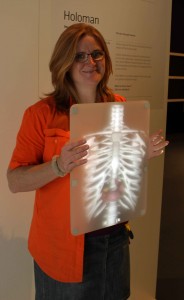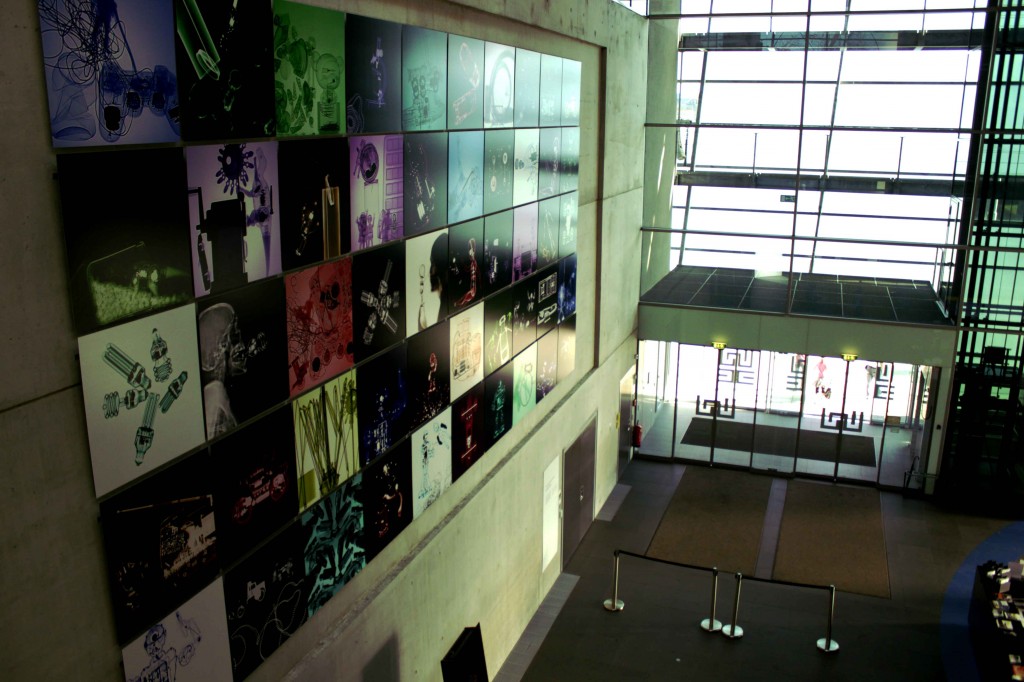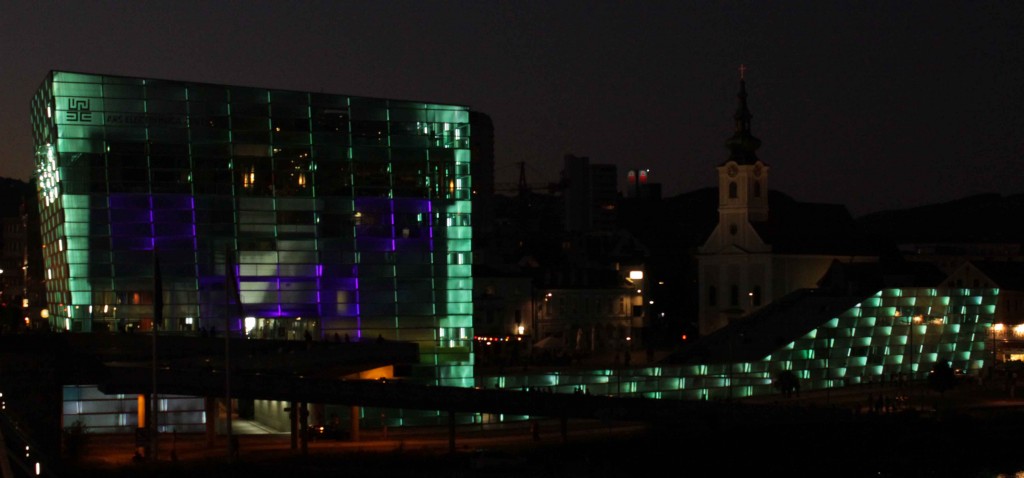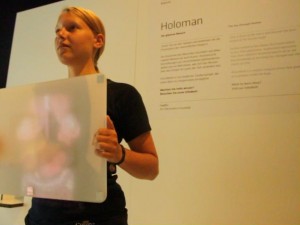Linz, Austria in October 2011
Among so much buttons and bright displays in the museum I decided to approach the module named Hallow Man. I then foolishly started to look for an interactive button that would tell me how it worked, shortly after realizing that the instructions were written on the wall. Realizing that I was a little bit lost within the simplicity of technology Kirsten came to my aid.
 “Take the white tablet and pass it through your body. Now look yourself at the mirror,” she clarified. With a slight smile of surprise and wonder I looked into the mirror and could clearly see the inner parts of my body.”Now turn it around and see what happens,” she added. I then watched the tablet and like a color X-ray I could see my muscle tissues, my blood veins, my bones and my beating heart. “Annika you have to come and see this”, I yelled to her from one side of the museum to the other.
“Take the white tablet and pass it through your body. Now look yourself at the mirror,” she clarified. With a slight smile of surprise and wonder I looked into the mirror and could clearly see the inner parts of my body.”Now turn it around and see what happens,” she added. I then watched the tablet and like a color X-ray I could see my muscle tissues, my blood veins, my bones and my beating heart. “Annika you have to come and see this”, I yelled to her from one side of the museum to the other.
Modules like this spring in the ARS Electronica Center, a museum that exhibits strong evidences of how art and science are the same face, but with different gestures. The history of this center goes back to the year 1979 when the ARS Electronica Festival was held for the very first time in Linz. The festival is still to this date celebrated in September and showcases and rewards innovations from all over the globe of media arts. Since then, the ARS Electronica as an institution, is dedicated in studying and promoting the consequences of the digital revolution in our society and the complex metamorphoses and interrelationships between art, technology, and society over time. This same objective lead to the founding in 1996 of this so called museum of the future.
Kristen told me that after 2 happy years of working here she could say that the most valuable asset of this museum is the creation environment that can be breath all through the building. “Here children can touch everything, do everything, learn everything and create anything they can,” she added. Kirsten also explained me how the museum can become very ambivalent. A situation that makes it so unique because the exhibitions can marvel you from the artistic point of view and / or scientific. For this same reason, experts and non-experts can not only interact but participate in the museum and be equally amazed.
 Divided into 4 floors the museum offers surprises through all its halls: GeoCity (interactive info-graphics of around the world), New Views of Human Kind (Robotics and Advanced Engineering), Artists, Creators and Engineers (permanent exhibition of their collection of New Media Arts) and Deep Space (a video projection) to name a few. The last mentioned is a projection that takes you through a wonderful journey to the far reaches of space at a resolution of 1080p HD format, 16 x 9 meters screen wide and in 3D that even Johannes Kepler himself would not have imagined seeing in his beloved Linz. The projection shows a unique way on how little or how much we know of our existence in space.
Divided into 4 floors the museum offers surprises through all its halls: GeoCity (interactive info-graphics of around the world), New Views of Human Kind (Robotics and Advanced Engineering), Artists, Creators and Engineers (permanent exhibition of their collection of New Media Arts) and Deep Space (a video projection) to name a few. The last mentioned is a projection that takes you through a wonderful journey to the far reaches of space at a resolution of 1080p HD format, 16 x 9 meters screen wide and in 3D that even Johannes Kepler himself would not have imagined seeing in his beloved Linz. The projection shows a unique way on how little or how much we know of our existence in space.
The museum also exhibits the results of the Futurelab. The Futurelab is a laboratory within the ARS Center that manages to unite the creative work being done in the artistic ateliers with the analytic and experimental work done in scientific laboratories in order to study the complicated interrelationships between art, technology and society.
For Kristen The ARS Electronica Center is just the beginning of this digital revolution. As a teacher and part of what she calls the harmonic museum staff thinking on telepathy as a possibility of communication is as viable as to show the inside of a human being with only a white tablet. Who knows, time will tell. The Ars Electronica Center is a place where man makes use of technology for it’s development and not for it’s destruction. A vision that lays a solid groundwork for building a better future for humanity.
Visit the website of the Ars Electronica Center and learn more about their projects.








Pingback: ARS: El Arte de la Ciencia | Tasting Travels